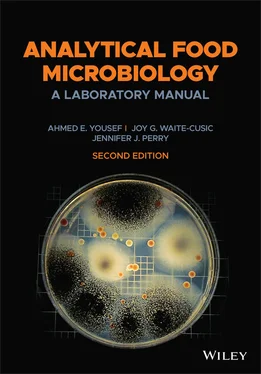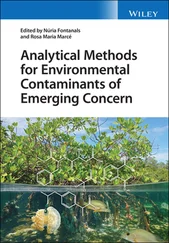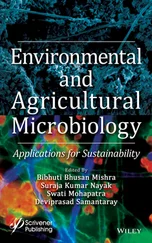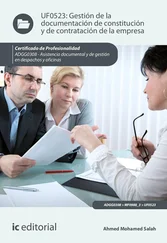To begin the counting process, the analyst should lay out the incubated plates in order of dilution to evaluate the executed dilution scheme and technique. The lowest dilution plated should have yielded the plate with the most colonies, and the number of colonies are expected to decrease by approximately a factor of ten as dilutions increase, provided that a decimal dilution scheme is used. If this is not the case, analysts should be cautious when interpreting results. Counting colonies on plates can be done visually, preferably with the help of a colony counter. Colony counters, such as the darkfield Quebec colony counter ( Figure 3.2), provide background lighting and magnification so that small colonies are not overlooked. To carry out this process accurately and rapidly, the analyst should mark the counted colonies with a marker pen on the bottom of the plate, to make sure that the same colonies are not counted repeatedly.
In order to obtain counts that can be compared among different laboratories, it is necessary to establish consistent guidelines for counting colonies. In some circumstances, however, different counting or calculation methods may be used in place of, or in conjunction with, the standard counting rules. The following are the rules that will be applied throughout this book for counting bacterial colonies.

Figure 3.2 Darkfield Quebec colony counter with a Petri plate mounted for colony counting.
Plates with colonies in the range of 20–200 (the best possible scenario)
Although other references may use 30 to 300 or 25 to 250 colonies as suitable countable bacterial colonies on a plate, the range 20–200 will be used throughout this book. If plating yields plates with colony counts in the range of 20–200/plate (as judged by a preliminary estimation), discard all remaining plates and count colonies only on the plates in this range. Calculate the CFU/g using equation 3.7. Familiarity with equation 3.7is important. Examples of dilution factors are 1/10 (i.e., 10 –1) and 1/100 (i.e., 10 –2), and the volume plated is commonly 1 or 0.1 ml.
Duplicate plates with colony counts in the 20–200 range are ideally obtained from one dilution only. When this condition is not met, the following rules are applied.
One plate in the 20–200 range. If the exercise yields only one plate with a colony count in the range of 20–200, calculate the CFU/g in the original sample using the number of colonies on that plate instead of an average.
Consecutive dilutions producing plates in the 20–200 range. If plates from two consecutive dilutions yield 20–200 colonies, compute the CFU/g resulting for each of the two dilutions. If the two population counts are not appreciably different (e.g., 1.5×104 and 1.2×104 CFU/g), average the numbers and report the average as sample population count. If the numbers are substantially different (e.g., the higher CFU/g is more than twice the lower one), report only the lower computed CFU/g.
Plates with < 20 colonies
If the plating procedure results in only plates with fewer than 20 colonies, record the actual number of colonies on the plates receiving the lowest dilution (i.e., the highest concentration of sample plated) and apply equation 3.7. In addition, report the number as “estimated” or “est.” For example, a sample of cooked meat was analyzed by pour‐plating 1 ml of sample dilutions 10 –2to 10 –4. Incubated plates produced less than 20 colonies and thus the count of microbial population in meat is calculated and reported as shown in Table 3.1.
When all plates produce no colonies, the count is estimated to be smaller than the minimum detection limit of the procedure followed. The minimum detection limit is the count that would result from the presence of one colony on the plate receiving the lowest dilution of the sample . Apply equation 3.4to estimate the count using the lowest dilution plated and substitute the numerator of the equation with < 1. For example, if no colonies appeared on any of the plates receiving the dilutions shown in the previous example ( Table 3.1), then
(3.4) 
It is not necessary in this case to report the count as “est.” because the presence of the less than (<) sign indicates the uncertainty of the count.
Plates with greater than 200 colonies
If the plating procedure yields only plates with greater than 200 colonies, obtain an estimated count as follows. Count colonies in representative portions (determined subjectively) of the plate receiving the highest dilution. Using a lighted colony counter with gridlines that are 1‐cm apart ( Figure 3.2) assists in choosing a representative area of the plate to count.
If there are fewer than 10 colonies per cm2, then count 13 squares chosen as follows: 7 consecutive horizontally and 6 consecutive vertically; see Figure 3.3for a visual example of plate counting field. The sum of the colonies in the 13 squares multiplied by 5 equals the estimated count per 65 cm2 plate, which is the area of a typical Petri dish, assuming its inner diameter is ~90 mm. TABLE 3.1 Microbial population count in cooked meat.Dilution FactorNumber of ColoniesPlate 1 Plate 2 10–2 {least dilute}12 16 10–33 1 10–4 {most dilute}0 0 Figure 3.3 Procedure to estimate microbial population count in samples using crowded plates (> 200 colonies/plate).
If the number of colonies per cm2 are from 10 up to 100 colonies, count colonies in 4 representative squares and multiply the average by 65 to give estimated count per plate ( Figure 3.3).
If there are greater than 100 colonies per cm2, then record the count as > 6500 CFU/plate ( Figure 3.3).
In all cases, equation 3.7is used to estimate population counts (CFU/g, est.). Never report the final count in the food sample as too numerous to count (TNTC). Plates with different surface areas, such as Petrifilms, are counted using the same principle. Count a minimum of 4 squares and average those counts, then multiply that count by the area of the plate being used.
Count a chain of colonies that are not too distinctly separated as a single colony. If colonies can be distinguished, then it is not considered a spreader for counting purposes. If chains of colonies appear to originate from separate sources, count each chain as one colony. If the spreader is greater than 25% of the plate, report the results as spreaders (Spr.) rather than as a number.
Which counting rule to use
The previous discussion is generally sufficient for determining which rule to follow for counting colonies and population resulting from a particular analysis. Alternatively, the counting rule to follow may be determined using a systematic approach, such as the decision tree described in Figure 3.4. Examples for applying most of these counting rules are shown in Figure 3.5. Note that slightly different rules are applied for counting fungal colonies; this is explained in the chapter dealing with enumeration of this group of microorganisms.
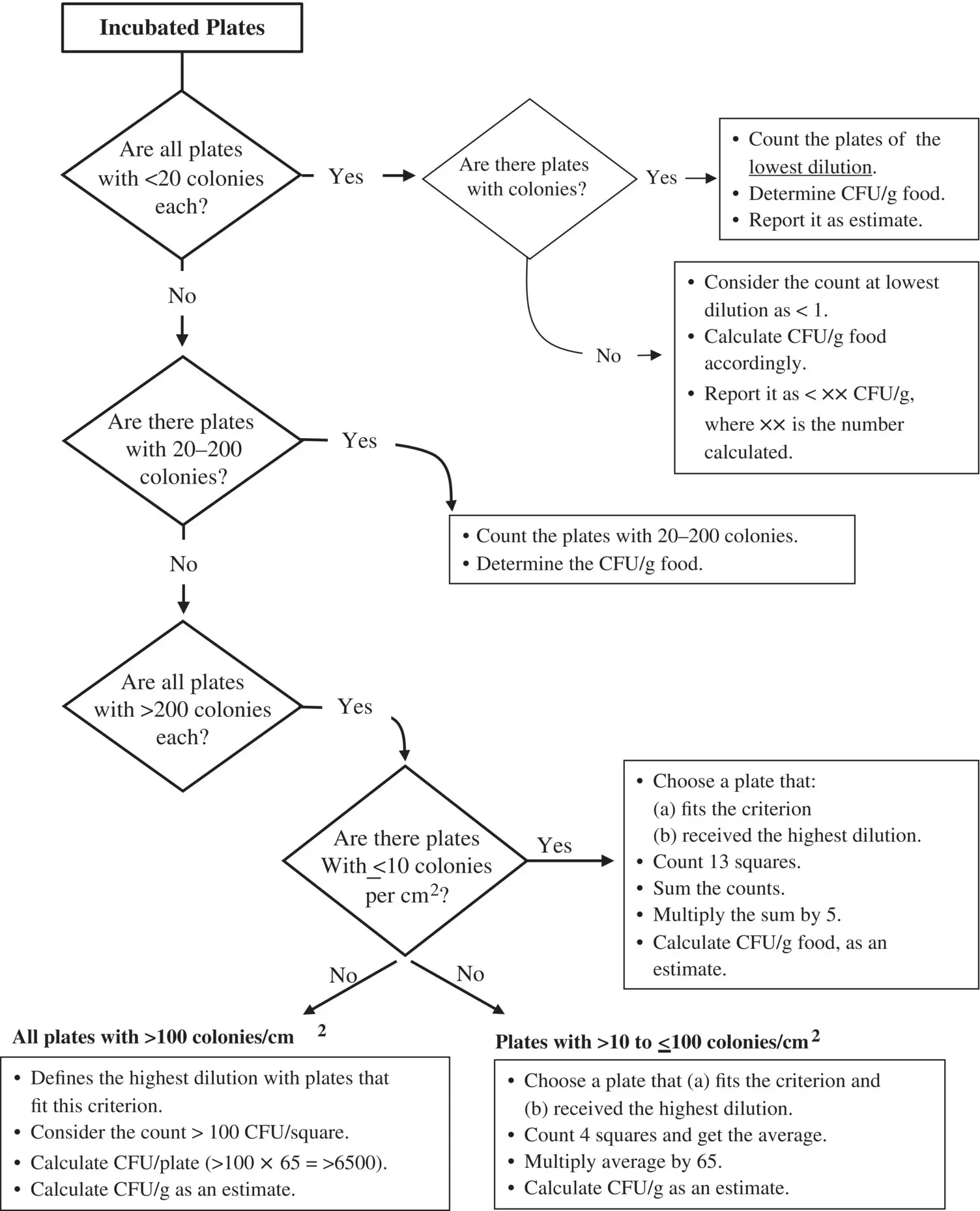
Figure 3.4 Decision tree for applying microbial colony and population count rules.
Читать дальше
